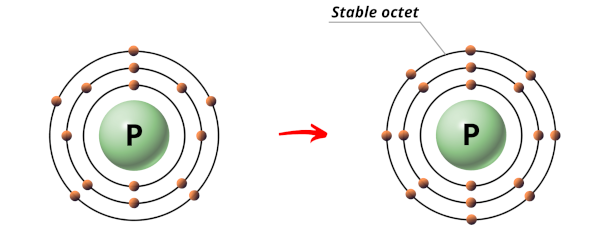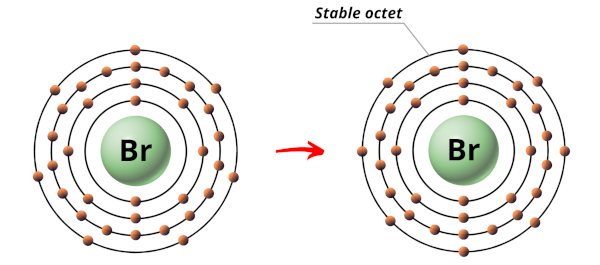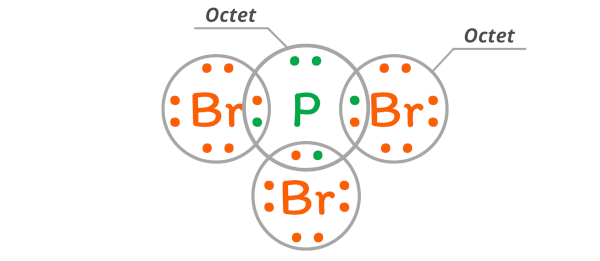
PBr3 is a covalent (polar covalent) compound because when one nonmetal combines with another nonmetal, it usually forms a covalent compound. Here, P is a nonmetal and Br is also a nonmetal. So when they combine, it forms a covalent compound.
Well, now you have got to know that PBr3 is a covalent compound, but let me explain the in-depth reason why PBr3 is a covalent compound.
Why is PBr3 a Covalent compound?
As mentioned above, you can simply remember that when the nonmetal combines with another nonmetal, the bond between them is a covalent bond.
Here in PBr3, the P atom is a nonmetal and the Br atom is also a nonmetal.

Hence the bond between them is a covalent bond.
How does the covalent bond form between P and Br?
In PBr3, there are two atoms;
P and Br.
About Phosphorus (P):
Phosphorus atom have 15 electrons.
The electrons arrangement in Phosphorus (P) is 2, 8, 5.
So the outermost orbit of Phosphorus atom has 5 electrons.
Now in order to achieve a stable octet, the Phosphorus atom needs 3 more electrons.

Hence during the chemical reaction, the Phosphorus atom will gain 3 electrons from the combining atom to form a stable octet.
About Bromine (Br):
Bromine atom have 35 electrons.
The electrons arrangement in Bromine (Br) is 2, 8, 18, 7.
So the outermost orbit of Bromine atom has 7 electrons.
Now in order to achieve a stable octet, the Bromine atom needs 1 more electron.

Hence during the chemical reaction, the Bromine atom will gain 1 electron from the combining atom to form a stable octet.
What happens when P and Br combine?
When P and Br combine with each other, the Phosphorus atom and Bromine atoms mutually share their 1-1 electrons with each other.
Because of this the phosphorus atom will have 8 electrons in its outermost orbit and similarly the bromine atom will also have 8 electrons in its outermost orbit.

As a result, the phosphorus atom as well as bromine atom will have a stable octet.
And finally, as the bond formed between the phosphorus and bromine is due to the mutual sharing of electrons, it is considered a covalent bond.
Thus, PBr3 is a covalent compound.
Is PBr3 polar covalent or nonpolar covalent?
In order to know whether PBr3 is a polar covalent molecule or nonpolar covalent molecule, we have to check the electronegativity difference of the combining atoms.

If the electronegativity difference (ΔEN) is less than 0.4, then the bond is nonpolar covalent bond.
If the electronegativity difference (ΔEN) is between 0.4 to 1.7, then the bond is polar covalent bond.[1][2][3][4]
Now the electronegativity of Phosphorus and Bromine are mentioned below. (You can see the electronegativity of all the elements from this electronegativity chart).
- Electronegativity of Phosphorus (P) = 2.19
- Electronegativity of Bromine (Br) = 2.96
So for PBr3, the electronegativity difference (ΔEN) = 2.96 – 2.19 = 0.77
This value lies between 0.4 to 1.7, which indicates that the bond between Phosphorus (P) and Bromine (Br) is polar covalent bond.
But the PBr3 molecule has 1 lone pair which results in an asymmetric shape of the entire PBr3 molecule.
Because of this asymmetric shape there are positive and negative poles of charges on the overall molecule of PBr3.

Hence, PBr3 is a polar covalent molecule.
I hope you have understood the reason why PBr3 is a polar covalent compound.
Check out other compounds to see whether they are ionic or covalent;
Is SrCl2 Ionic or Covalent?
Is SCl2 Ionic or Covalent?
Is K2S Ionic or Covalent?
Is SF4 Ionic or Covalent?
Is Br2 Ionic or Covalent?
Jay is an educator and has helped more than 100,000 students in their studies by providing simple and easy explanations on different science-related topics. With a desire to make learning accessible for everyone, he founded Knords Learning, an online learning platform that provides students with easily understandable explanations.
Read more about our Editorial process.
